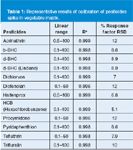Analysis of 258 Pesticides in Vegetable Matrix Using Triple Quadrupole GC–MS–MS
Bruker Application Note
Introduction
Gas chromatography (GC) coupled to a triple quadruple mass spectrometer (GC–MS–MS) operated in multiple reaction monitoring (MRM) mode is an ideal technique for multi-residue analysis in complex matrix samples (1,2). MRM can greatly enhance the sensitivity through increased specificity and selectivity by reducing the background signals from matrix. Moreover, multiple MRMs from co-eluted residues can be monitored simultaneously.
This application note describes a GC–MS–MS method for detection of 258 pesticides in a vegetable matrix after extraction using the QuEChERS (Quick Easy Cheap Effective Rugged and Safe) method.
Experimental
The vegetable matrix was prepared by performing QuEChERS extraction on the mixed colour peppers according to the established procedure (3). The final acetonitrile extract was reconstituted in 9:1 hexane:acetone before spiking pesticide standards for matrix-matched calibration experiments ranging from 0.1 to 100 ppb.
The GC–MS–MS analysis was performed on a Bruker Scion TQ triple quadrupole mass spectrometer equipped with a Bruker 451 GC using hot splitless injection of 2 µL. The pesticides were separated on a Bruker BR-5ms capillary column of 30 m × 0.25 mm i.d. and 0.25 µm film thickness under the constant helium flow of 1 mL/min.
The MRM method for 258 pesticide residues (each with 2 MRM) was set up using the Compound Based Scanning (CBS) of the MSWS 8.0 software with a factory provided MRM library. The MRMs and their optimized collision energies for each compound were stored in the library under the compound name. Building the MRM table was achieved by selecting a list of target residues from the library to import into the method editor (4).
Results and Discussion
With the CBS, the MRM method development is simplified and there is no need to input manually the MRM transitions for those target residues in the MRM library. Also, the scan time (dwell time) for each compound and their MRMs can be optimized automatically for both the sensitivity, for good quality peak at low concentrations, and the duty cycle, for sufficient data points (>15) across each peak.
The method sensitivity for most of the compounds can reach 0.1–0.5 ppb (LOQ) and with good linearity up to 50 or 100 ppb (compound dependent). The representative results are summarized in Table 1. As shown, the average response factors over the entire calibrations range have RSD ≤ 12%, demonstrating the excellent method precisions for analysing these pesticides in the complex sample matrix.

Table 1: Representative results of calibration of pesticides spike in vegetable matrix.
Conclusions
The method has demonstrated its sensitivity and robustness in detecting 258 pesticide residues in matrix. The CBS has greatly simplified the method development for multi-residue analysis for improved productivity.
References
1. Rapid Commun. Mass Spectrum., 20, 365–375 (2006).
2. J. Agric. Food Chem., 58, 5868–5883 (2010).
3. J. AOAC Int., 86, 412–431 (2003).
4. Bruker Daltonics Application Note # CA 281751-3 (www.bdal.com/lcgc-pesticides).
Bruker Daltonik GmbH
Fahrenheitstr. 4, 28359 Bremen, Germany
tel: +49 421 2205 0 fax: +49 421 2205 104
E-mail: sales@bdal.de
Website: www.bdal.com

New Study Reviews Chromatography Methods for Flavonoid Analysis
April 21st 2025Flavonoids are widely used metabolites that carry out various functions in different industries, such as food and cosmetics. Detecting, separating, and quantifying them in fruit species can be a complicated process.
Analytical Challenges in Measuring Migration from Food Contact Materials
November 2nd 2015Food contact materials contain low molecular weight additives and processing aids which can migrate into foods leading to trace levels of contamination. Food safety is ensured through regulations, comprising compositional controls and migration limits, which present a significant analytical challenge to the food industry to ensure compliance and demonstrate due diligence. Of the various analytical approaches, LC-MS/MS has proved to be an essential tool in monitoring migration of target compounds into foods, and more sophisticated approaches such as LC-high resolution MS (Orbitrap) are being increasingly used for untargeted analysis to monitor non-intentionally added substances. This podcast will provide an overview to this area, illustrated with various applications showing current approaches being employed.

.png&w=3840&q=75)

.png&w=3840&q=75)



.png&w=3840&q=75)



.png&w=3840&q=75)
















